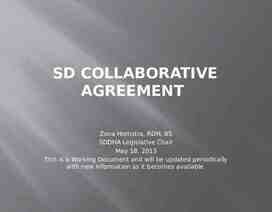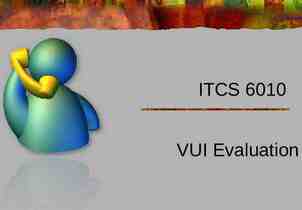Graduate Students’ Perceptions of Computer-Based Project and Systems
17 Slides985.50 KB
Graduate Students' Perceptions of Computer-Based Project and Systems Engineering Management Methods Amira Sharon, Olivier L. de Weck, Dov Dori LINC 2010 MIT
What-When Relations in Systems Engineering Management (SEM) ProjectWhen Management Planning Management Plans (PMP, RMP ) Organizing Systems What Engineering Requirement & Functional Analysis Model-Based Paradigm Formal and Allocation Specifications Design Synthesis Custom Reports C.1 BMD Command & Control *Launch Command *Sensor Commands Universe Component Management Reports Directing and Queries *Launcher Status Launchers *Interceptor Status and Queries C.2 *Ignition Collectors Component S.1.1 Radar s1 . Inve nto ry Prod uct 5 0.1 5 0.4 s1.Make Colle ction Req ue st syste m s1 . Colle ction Req ue st AN D s1 . Forma tted Req ue st 5 0.2 system AN D AN D 50 .3 s1.Acce pt & Forma t Request 50 .5 s1.Ge t P rod uct F rom Inventory s1.P rovid e P rod uct to User s1 . Inve nto ry Prod uct s1. Co lle ctio n P rod ucts A ND 5 0.6 s1 .Check P rod uct Invento ry use r s1.Acce pt P rod ucts s1 . Formatted Req ue st Verification R e s o u rc e M IP S 5 0 F u n c tio n D e te c t & F u n c tio n T h re a t T r a c k F u n c tio n (W F u n c tio n R e q u e s t In te rc e p t F u n c tio n P e rfo r m In t e rc e p t F u n c tio n A s s e s s K il l ith In i t i a t e T ra c k E x it s ) D i s c r i m i n a 0 2 SYS.1 Collection Manageme nt System System Systems Analysis and Control (Balance) Integration & user Control Customers Component Interceptors *Track Data Monitoring C.3 1 0 2 0 3 0 4 0 5 0 5 7 .0 S.1.2 Analyst/Workstation Analyst/Command Center Component Component
Project/Product What-When common Relationsareas in SEM Adapted from NASA (2005) Project Management Planning Organizing Directing Monitoring Control 3 Common Areas Risk Mgt. Config Mgt. Performance Evaluation Mission Assurance Systems Engineering Requirement & Functional Analysis and Allocation Design Synthesis Systems Analysis and Control (Balance) Integration & Verification The managerial part of SEM is conducted mostly by using traditional PM methods
The Research Context Conducted within the ProjectProduct Lifecycle Management (PPLM) research aimed to develop a combined project-product methodology and conceptual model, containing both domains, linked with explicit relationships. 4
Research Questions 1 & 2 Notes 5 Research Method Questions focus is put on Structured (1) While conducting the seven PM questionnaires systems engineering methods management, to what Based on a extent do 24 participants UAV case practitioners perceive a notion of a projectdomain, a productdomain, and a combined projectproduct domain? (2) How do systems engineers perceive the extent to which the common PM methods support SEM? Topic # Application of Project Management Methods within Systems Engineering Management 1, 2
The Unmanned Aerial Vehicle (UAV) Case UAV Project Description (NMA-X1) Situation You have recently been promoted to Project Manager at New Millennium Aerospace (NMA) Inc., a leading manufacturer of unmanned aerial vehicles (UAVs) for the government. Your new job is to plan and execute the development project for a UAV, to be used for surveillance purposes. A rough specification and sketch of the new vehicle is shown in Figure 1. The payload is provided by the government as modified GFE (government furnished equipment), while the engine will be supplied by a well-established commercial company (ECC) under a subcontract. The remainder of the vehicle, including integration and testing is NMA’s - and therefore your - responsibility. Your task today is to create a project schedule, find the critical path and to estimate the finish time of the project. The subsequent project description is hypothetical, but will help you establish the plan.
The UAV Case – project description story UAV Project Description (NMA-X1) The UAV “pusher” vehicle concept is shown in Figure 1. In a pusher aircraft, the engine is rear-mounted which can lead to higher propulsive efficiency. The vehicle can be decomposed into the following assemblies: fuselage (houses the avionics suite), wings, empennage, payload (a visual and an IR camera, incl. transmitter) and the engine (incl. propeller). empennage fuselage b avionics suite wings B payload L engine Fig 1. UAV concept, Specifications: L 2000 mm, B 3500 mm, b 500 mm
After the project start (a,0) you first have to complete the overall requirements definition (b,10) step. Once this is accomplished you can carry out the following jobs in parallel: negotiate the engine specification (c,5) with ECC, define your payload specification (d,5), determine the vehicle layout (e,8) and write the software specification (g,12). You can initiate(GFE) avionics design (f,15) after (b,10), however the tasks (c,5) and (d,5) must also have been completed before the GFE design can be started, so that the avionics will be able to control both the engine and payload in a synchronized fashion. Once the engine specs (c,5) have been defined, the supplier (ECC) informs you that it will take 30 days for engine development (i,30) based on experience with a previous variant. Once engine development is complete, delivery and checkout (n,2) can take place at NMA’s facilities. After (d,5) is done, payload development (j,15) can take place in parallel with engine development. Once the payload is developed (j,15) and the engine delivered (n,2), both the engine and payload are integrated (electrically) in the power system integration (o,10) step. Fuselage design (k,17) and empennage/wing design (l,15) begin in parallel after the vehicle layout (e,8) has been established. Internal fittings (m,8) can be designed after these two jobs are completed. Also, structural airframe prototyping (r,8) consists of building a physical frame for the vehicle after jobs (k,17) and (l,15) are completed. Once avionics design (f,15) has been completed, this leads to avionics delivery and checkout (p,12) and subsequent avionics/software integration (q,5). Obviously, in order for this last step to take place, software development (h,25) which depends both on (g,12) and (f,15) must have also been completed. The project is continued by performing vehicle integration (s,10) which requires prior completion of power system integration (o,10), airframe prototyping (r,8) and avionics/software integration (q,5). After vehicle integration (s,10) and internal fitting design (m,8) have been achieved , final vehicle assembly (t,5) can begin. After final assembly, the completed vehicle is subjected to laboratory testing (u,5), followed by an outdoor flight test campaign (v,10) leading to completion of the prototype development project, finish (w,0).
Method for Research Questions 1 & 2 The seven investigated project management methods Object Process Methodology Gantt chart Earned Design Value Structure Method Matrix Critical Path Method Program Evaluation and Reviewing Technique System Dynamics OPM Gantt EVM DSM CPM PERT SD HW5 HW5 HW4 HW3 HW2 HW2 HW1 Reviewed prior to HW Reviewed prior to HW 1 2 1 1 6 * The MBPP approach was presented during 1.5 sessions (4.5 hours). 9 Project management method – short name Project management method – full name Homework assignment Number of 3hour sessions devoted to method
Instructions to the Participants The question posed to the participants was phrased as follows: "Please compare the project models or representations you have done so far as homeworks, with respect to the following Project Management (PM) Considerations. Utilize the excel file entitled HW5 Q4 for this purpose. Wherever you believe a correlation exists between a model and a PM consideration, provide a short written explanation of the relationship and grade its strength numerically (between 1 and 5)." 1 is poor, 2 is fair, 3 is good, 4 is very good, and 5 is excellent. N/A was denoted by 0.
Method for Research Questions 1,2 The 14 Systems Engineering Management Factors 11 Dimension Project Project Project-Product Project Project-Product Product Product Product Product Project-Product Project Project-Product Project-Product Project-Product SEM Factor Budget/Schedule measurement/tracking Budget/Schedule forecasting Inter-relationships (process & product) Resource management Stakeholders/agents tracking Performance quality Product quality Product planning Product measurement/tracking Risk management Iterations management Information resolution level Ease of communication Change management 1 2 3 4 5 6 7 8 9 10 11 12 13 14
Method for Research Questions 1,2 Using Alpha Cronbach coefficient The Alpha Cronbach coefficient α was calculated for estimating how well the set of variables measures each single one-dimensional underlying construct. k 1 k 1 k i 1 2 i 2 T k is the number of items, i2 is the variance of the ith item, and T is the variance of the total score formed by summing all the items of the tested sample. 12
Results for Research Questions 1 & 2 All Factors Set Reliability OPM Gantt EVM DSM CPM PERT SD Project Management Method System Dynamics Full name Object Process Methodology Gantt Chart Earned Value Method Design Structure Matrix Critical Path Method Program Evaluation and Reviewing Technique .855 .760 .757 .640 .754 .793 .743 - - - .702(1) - - - Cronbach's Alpha Best Improved (1) Improved by deletion of factor 12 – Information Resolution Level and factor 3 - Inter-relationships (process & product) 13
Results for Research Questions 1 & 2 Project Management Methods Comparison by Sum of SEM Factors Rankings 14
Results for Research Questions 1 & 2 Findings for the defined dimensions OPM Gantt Object Process Methodology DSM CPM PERT SD System Dynamics Full name Earned Value Method Design Structure Matrix Critical Path Method Program Evaluation and Reviewing Technique - - - Project Dimension - - - - Product Dimension - - - - - Project-Product Dimension Combined Project-Product Dimension 15 EVM Project Management Method - - -
Results for Research Questions 1 & 2 Project management methods comparison by dimension 16
Research Questions 1 & 2 Notes Research Method Questions focus is put on Structured (1) While conducting the seven PM questionnaires systems engineering methods management, do practitioners perceive a 24 participants notion of a projectdomain, a productdomain, and a combined project-product domain? (2) How do systems engineers perceive the extent to which the common PM methods support SEM? 17 Topic # Application of Project Management Methods within Systems Engineering Management 1, 2






















